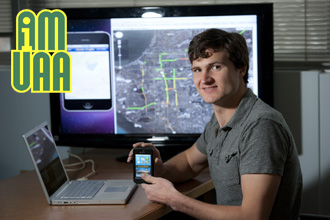I AM UAA: Tim Menard
by Kathleen McCoy |
B.S. Electrical Engineering '12
Hometown: Schaumburg, IL
Fun Fact: Is a jazz musician and tinkers with model trains
One look at Tim Menard's CV will give the impression that he's far beyond his years. At just 22, this senior electrical engineering student has kept his undergraduate years packed, conducting important research, publishing papers, winning awards and gaining the attention of leading industry executives.
 Tim came to UAA from Schaumburg, Ill., a suburb of Chicago. A longtime model train
enthusiast, Tim's fascination with the Alaska Railroad ultimately led him to The Last
Frontier. "I've wanted to come to Alaska for a long time, ever since I was a little
kid," he said. After high school, Tim completed two years at a local community college
before deciding to make the move north.
Tim came to UAA from Schaumburg, Ill., a suburb of Chicago. A longtime model train
enthusiast, Tim's fascination with the Alaska Railroad ultimately led him to The Last
Frontier. "I've wanted to come to Alaska for a long time, ever since I was a little
kid," he said. After high school, Tim completed two years at a local community college
before deciding to make the move north.
He and his mother attended a preview day at UAA in February 2008 to check out his options. "It was a beautiful winter day; I knew then I was going to come here," Tim said.
Needing to test his independence before leaving home, Tim set off on a backpacking trip across Europe the summer before coming to Anchorage. After arriving home from his adventure, Tim hopped in his Jeep and headed up the Alaska Highway to start his next chapter in Alaska.
"I got up here and just hit the ground running," Tim said. He got involved with USUAA Student Government and helped initiate the group's first legislative luncheon and masquerade ball events. He also played trombone with the UAA Jazz Ensemble and was a member of the Kappa Sigma fraternity.
"I was doing so much that I had to start cutting some things out to concentrate on my studies," he said. He changed his focus and started putting 100 percent of his energy into earning his engineering degree.
A programming class with UAA engineering associate professor Jeffrey Miller required Tim to complete a project to enter into the School of Engineering's semiannual Student Design Competition. His project-a terrain map to determine road incline-led to another idea to monitor the progress of Anchorage's snowplows.
Using traffic simulator software developed by Miller, Tim came up with the idea to design and create devices that would be placed on snowplows in the Anchorage Bowl to track what roads had been plowed and when. The software, FreeSim, enables data from the devices to be available online so people can see if their route has been plowed.
Tim is currently working with UAA's Facilities Department to test his system on the university's snowplows. "If we can show a solid proof of concept, there's a good chance the Municipality of Anchorage will pick up on this," Tim said. Tim and Miller are currently working to obtain a provisional patent for their work.
Tim has also helped develop FreeSim 2.0, an expansion of the original software, which shows real-time traffic of Anchorage. He's also developed two iPhone apps: FreeSim_Mobile and UAA Info, an app for students to quickly gather resources about the university. His FreeSim_Mobile app took first place in the Student Design Competition two times in a row.
Tim's work at UAA has resulted in five published research papers, three of which he is the primary author. His research focuses on software, hardware and network architectures used in mobile and wireless communication within the applications to Intelligent Transportation Systems with an emphasis on Vehicle to Infrastructure and Vehicle-to-Vehicle communication.
Through IEEE, Tim has attended several international conferences. His poster, "Determining Time to Traverse Road Sections Based on Mapping Discrete GPS Vehicle Data to Continuous Flows," earned honorable mention at the IEEE 6th Intelligent Vehicles Symposium in La Jolla, Calif. This distinction was given to only five of 250 posters.
It was his attendance at one conference that changed the course of Tim's life. While at the 2010 IEEE Vehicular Networking Conference in New Jersey, Tim's work piqued the interest of a Toyota executive researcher, who later offered him a prestigious graduate-level internship in Silicon Valley, Calif. During his summer 2011 internship, Tim developed a simulation tool for visualizing vehicular mobility to show how traffic will impact vehicular networks. Impressed by Tim's work, Toyota has expressed a sincere interest in his future, going so far as to offer support for his education upon acceptance to Stanford University.
This emerging innovator says that UAA's classes are challenging and the professors are approachable. "UAA is a small campus and anyone who has an idea can run with it," Tim said. "I wouldn't have had these opportunities anywhere else." Tim plans to pursue his graduate degree upon earning his B.S. in Electrical Engineering from UAA in the spring.
 "I AM UAA: Tim Menard" is licensed under a Creative Commons Attribution-NonCommercial 4.0 International License.
"I AM UAA: Tim Menard" is licensed under a Creative Commons Attribution-NonCommercial 4.0 International License.









